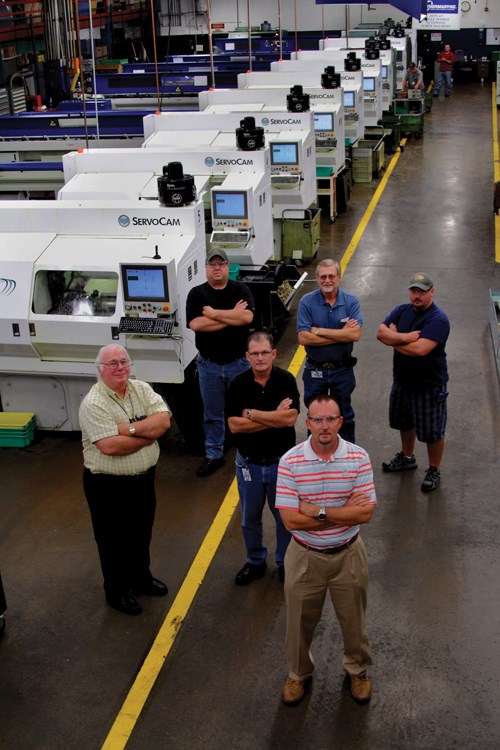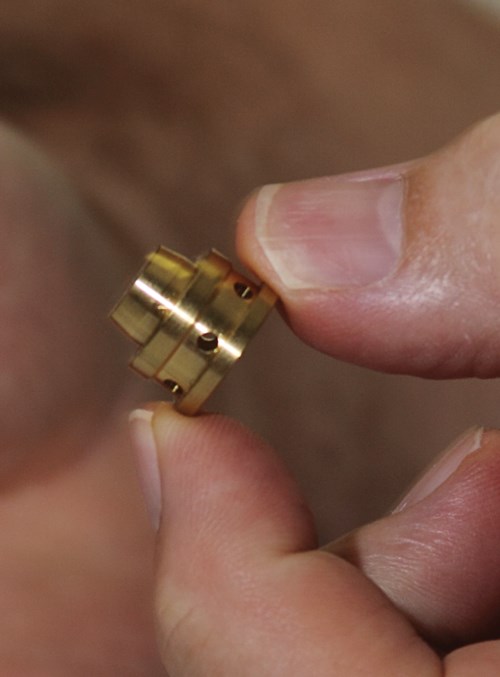Metamorphosis of a Brown & Sharpe Department
This plant needed to maximize machine utilization and decrease labor costs. It began by upgrading its Department 417 Brown & Sharpe single-spindle screw machines.
To implement a new corporate manufacturing strategy, Thermadyne Industries’ Denton, Texas, plant needed to maximize machine utilization and decrease labor costs. It began by upgrading its Department 417 Brown & Sharpe single-spindle screw machines, and in doing so, has now exceeded its initial objectives. Running no additional shifts, each new machine has replaced two and a half cam-operated Brown & Sharpes. Setup times have decreased from 4 hours to 1.5 hours, and labor costs per part have been reduced by 60 percent.
Steve Finley, plant manager, says, “The upgrade of Dept. 417 has met all of the objectives of our manufacturing strategy and significantly helped our U.S.-based manufacturing to be more competitive with overseas sources.”
Thermadyne manufactures high-performance welding and cutting equipment in plants around the globe. The company’s Denton plant has 190,000 square feet of manufacturing space that holds 21 multi-spindles, 25 CNC lathes, 36 CNC Swiss, two palletized machining centers, six CNC mills, five rotary transfer machines and five high-speed drilling machines. Until 3 years ago, the plant also ran 23 late model, cam-operated Brown & Sharpe screw machines.
New Manufacturing Strategy
To keep Thermadyne at the forefront of the competitive welding industry, in 2007, upper management created a new manufacturing strategy that involved reducing the labor content of parts, identifying and adopting easily transferable technology and maximizing the use of assets.
The company initially implemented this strategy in Department 417, the Brown & Sharpe department. The department was producing lot sizes ranging from 200 to 2,000 pieces, cycle times were typically between 10 and 30 seconds, setup times averaged 4 hours, technology transfer was slow (with 6 months required to train a basic setup/operator) and new jobs and engineering changes took several days (at best) to implement—requiring cam layout, cutting and grinding, and heat treating.
Based on this analysis, Charles Monschke, principal process engineer, concluded that they needed to reduce setup times to address high labor costs, match or improve existing part-cycle times with any new machinery or processes, adopt control technology offering a fast learning curve and minimize production-process development and modification time.
Thermadyne soon discovered the rapid setup claims for the ServoCam UltraTurn XL machines from AMT Machine Systems. The XL is a fully-enclosed, single-spindle CNC screw machine and is compatible with the existing Brown & Sharpe tooling. The screw machine is designed to offer both the rigidity and the high cutting forces required for screw machine production rates. Thermadyne discussed its applications with the AMT team and received favorable cycle time analyses.
The next step was a part runoff at AMT to verify the setup and cycle time claims. Mr. Monschke and Craig Taylor, senior manufacturing engineer at Thermadyne, arrived at AMT with the tooling for the runoff. Based on bringing a mix of left- and right-hand tooling, they thought the runoff was in jeopardy. But in a matter of minutes, AMT was able to modify the part-cycle program and proceed with the runoff without significantly altering the setup time or the cycle time. Mr. Monschke says it would have taken days to make those changes using cam technology. The UltraTurn XL appeared to be an excellent fit for the company’s new manufacturing strategy.
2-Month Results
Thermadyne received two ServoCam UltraTurn XL machines in the fourth quarter of 2008. The results achieved in the first 2 months of operation met or exceeded their expectations. Setup times were reduced to 1.5 hours, within weeks of initial training, and cycle times were immediately reduced by an average of 20 percent, a bonus to the company’s cost justification. A CNC setup/operator was retrained as an UltraTurn setup/operator in only 2 weeks.
The setup and cycle-time reductions substantially lowered the labor content of Thermadyne’s parts. Using both screw machine and CNC operators, production goals were achieved in less than 2 months, which is a testament to the ease of technology transfer.
Having exceeded justification criteria for Brown & Sharpe machine replacement, Thermadyne began testing the XL’s ability to run work from other machine platforms.
Based on these results, the company expanded its departmental upgrade plans to include more XL machines for moving low-volume work from multi-spindles and for moving simpler parts from CNC lathes and CNC Swiss. “Even when part-cycle times are the same, the machine cost is much higher for the CNC Swiss machines,” Mr. Monschke says. The Great Recession delayed the implementation for a few months, but in late 2009, the departmental metamorphosis began.
Fast Forward to Present
Thermadyne operates nine of the XL machines in its Denton plant, another four in a plant in Hermosillo, Mexico, and has three more machines on order. The results continue to be outstanding.
After adopting the XL platform, Thermadyne easily achieved its goal of labor-content reduction. The new machine’s CNC control system eliminates a large number of labor-intensive setup operations that add zero value to the final product. As a result, each setup/operator is now producing 2.5 times the quantity of parts they were making on cam machines, giving a 60 percent labor-cost reduction per part.
Thermadyne also achieved its goal of adopting easily transferable technology. First, its experienced Brown & Sharpe setup/operators became proficient with the new CNC-controlled machine in only a few setups.
Second, training time for new setup personnel has been dramatically reduced. Thermadyne has long had a formal hands-on, setup training process. For trainees with basic machining knowledge, but no Brown & Sharpe experience, about 6 months of training was needed before they could independently perform basic cam-machine setups.
“I was the trainer on cam Brownies, and now on the UltraTurn machines,” Chad Hair, XL setup/operator says. “I can teach in 4 weeks what used to take me 6 months.” This has enabled Department 417 to rapidly increase production, with no major bottlenecks resulting from the nationwide manufacturing skilled labor shortage.
Thermadyne’s disciplined approach to both technology and process improvements also produced outstanding results for its final, and perhaps most important, strategic objective: Maximize utilization of assets. The company achieved a 150 percent increase in productivity from its human assets, while at the same time, improving job satisfaction. Each UltraTurn XL machine produces as many parts as two and a half cam machines, enabling Department 417 to increase production with no expansion of facilities or personnel. This enabled the company to move work from more expensive platforms to the XL machines, reducing capital expenses per part produced.
“This is one of the simplest justifications of my career,” Mr. Monschke says. “The projected payback period was less than 8 months, based on setup reduction alone. And the actual payback numbers were even better than I projected.”
Latest Challenge
Thermadyne management recently mandated a minimum of 12 inventory turns per year. This directly impacted the multi-spindle department, which had often produced 3, 6 or even 12 months of inventory per run. Now, the lower-volume parts are no longer economical to run on the multis. Mr. Taylor was charged with moving those parts to alternate work platforms. Of the 300 jobs targeted to be moved off the multis, 75 percent of them are now run on UltraTurn XLs.
Mr. Taylor retooled the jobs to run with the XL’s two cross slides and two vertical slides, instead of a multi’s six or eight cross slides. “We use a semi-finish form tool to remove most of the material, then follows with a 20-degree skive tool,” Mr. Taylor says. “This process has provided the diameter control necessary for thread rolling, as well as superior finishes.”
Not only has the Thermadyne team replaced their cam-operated Brown & Sharpe machines with the ServoCam UltraTurn XL platform and drastically reduced both cycle times and setup times, but they have resolved its skilled-labor shortage issues and have placed the right work on the right machines.
Yet the metamorphosis of Department 417 is about more than just numbers. The work environment is now safer, with much less oil on the floors and interlocked enclosures on the XLs. The entire area is quieter, and the appearance of the department is a source of pride.
Related Content
Bridging the Gap Between Traditional Single- and Multi-Spindles
This twin-spindle automatic lathe with six cross-slide mounted turrets is designed for medium-sized production runs that might not be suitable for conventional multi-spindles.
Read MorePMTS 2023 Product Preview: High-Volume Turning
Learn about some of the latest high-volume turning solutions that will be on display at PMTS 2023.
Read MoreCAM-Driven Lathe Questions
There can be hidden issues using legacy cam-driven lathes that can be overcome using new CNC technology. Here are three to keep in mind.
Read MoreIndex Corp. Turnkey Solutions Provide Flexible Manufacturing Performance
IMTS 2024: Index's C200 FANUC features powerful twin spindles that achieve rapid material removal.
Read MoreRead Next
CNC Upgrades Breathe New Life Into Brownies
Used in lean manufacturing processes, multis can suffer from long setup times. Upgraded Brownies often compete very favorably with multis on medium-length runs.
Read More5 Aspects of PMTS I Appreciate
The three-day edition of the 2025 Precision Machining Technology Show kicks off at the start of April. I’ll be there, and here are some reasons why.
Read MoreEmerging Leaders Nominations Now Open
Here’s your chance to highlight a young person in your manufacturing business who is on the path to be a future leader moving your company forward.
Read More










.jpg;maxWidth=300;quality=90)


.jpg;maxWidth=300;quality=90)













